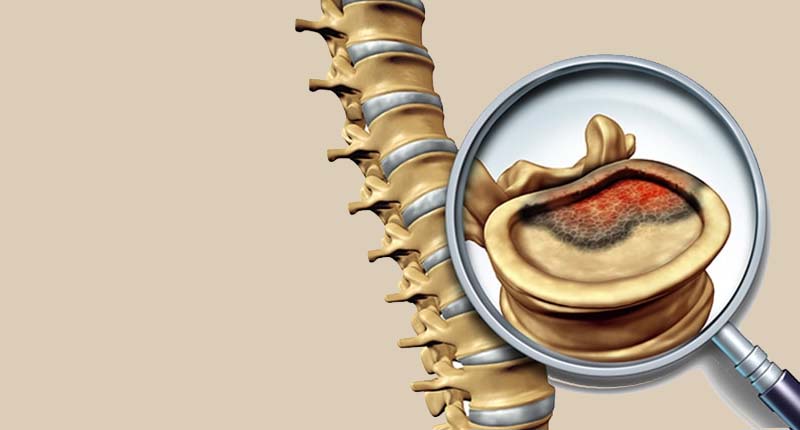rimary spinal tumors basically develop in the spinal column, like inside the bones, discs, nerves, etc. These tumors are mostly noncancerous (benign) & commonly occur in the younger age group. Secondary spinal tumors (metastatic tumors) are tumors that have reached the spine from a cancer site that started somewhere else in the body, especially from lung, breast, and prostate. These tumors are common types in the spine and are cancerous.
Neurofibromatosis is a genetic disorder that sometimes maybe the reason for tumors in the spinal cord. Dr. Yash Shah is one of the most reputed Spine Tumor Surgeon In Kandivali, Mumbai. To get safe & effective spinal tumor treatment, Book Your Appointment Today!
What are the Symptoms of Spinal Tumours?
The most typical symptom of a spinal tumor is back pain, particularly in the middle or lower back. Some people may complain about neck pain too. The pain seems to worsen with an increase in physical activity. Pain intensifies at night when the person is lying down. Sometime pain may also felt in the hip, arm, leg, or feet.Other signs and symptoms may be visible depending upon the type & location of the tumor.
Further symptoms can involve
- Lack of sensation in the legs, arms or chest.
- Stiff neck.
- Difficulty walking resulting in frequent fall.
- Diminished sensation to heat & cold.
- Failure of bowel or bladder functioning.
- Paralysis.
- Spinal deformity due to large or deadly tumor.
What Causes Spinal Tumours?
Primary or secondary spinal tumor - both are caused due to abnormal growth of cells. Medical experts are not sure about the cause of the primary spinal tumor that originates in the spine and what leads to abnormal cell growth. Few cases can be due to exposure to radiation or cancer-causing chemicals. Genetics also are responsible for primary spinal cord tumor - genetic disorders like neurofibromatosis comprise tumors on or near the spinal nerves. Secondary spinal tumors result from metastasis, i.e., cancer that has reached from another part of the body having a cancer tumor.How is Spinal Tumor Diagnosed?
A meticulous medical analysis with importance to back pain and its causes is the primary step to diagnosing a spinal tumor. One has to undergo radiological tests for the accurate diagnosis & treatment of spinal tumors.- X-ray: X-rays of the spine are taken to search for a spinal tumor or other possible causes of pain like infections, fractures, etc. Alone X-rays can't be very accurate in diagnosing tumors.
- Computed tomography scan (CT scan): A CT scan can determine the shape and size of the spinal canal, its contents, and its structures. It further is quite prominent at visualizing skeletal structures.
- Magnetic resonance imaging (MRI): An MRI helps in viewing the spinal cord, nerve roots, and nearby areas, as well as tumors.
- Bone Scan: Effective as an auxiliary for the association of bone tumors & infections.
How is Spinal Tumor Treated?
Non- Surgical Spinal Tumor Treatment
The nonsurgical choices for managing spinal tumors is a combination of observation, chemotherapy & radiation therapy. Any tumors that are not showing significant or aggressive symptoms may be observed and monitored with consecutive imaging, mostly MRI). A sequence of chemo- or radiation therapy may be the initial line of treatment in these situations.Surgical Spinal Tumor Treatment
Surgical options for the spinal tumor treatment varies from total to partial removal of the tumor. Spinal tumor surgery demands a necessary measure of precision. While tumors that are close to the spinal cord can often be removed, a surgeon must be cautious not to hurt the spinal cord or other major nerves of the spine.There are numerous surgical treatment approaches that a doctor can practice when conducting spinal tumor surgery.
For instance, a surgeon might:
Perform en bloc resection in which the surgeon removes the entire tumor in a single piece A practical approach that provides excellent visibility of the never root, helping in the removal of tumors via an incision in the back.
Removing tumors by minimally invasive surgery in which a series of small incisions are made. This approach reduces the risk of infection, scarring & other complications.
Using embolization of spinal tumors technique - this technique reduces the risk of blood loss during surgery. Small beads of a glue-like liquid are injected into the blood vessels that feed the tumor.
If a surgeon believes that a spinal tumor cannot be successfully removed, he or she might suggest a different type of surgical intervention:
Surgical decompression of the spine. This procedure may be performed before radiation therapy to reduce the risk of spinal cord injury further or relieve pressure if a tumor is pressing the spinal canal.
Strengthen the spine with pedicle screws and rods which help scatter the stress laid on the bones by a large or metastatic spinal tumor.


